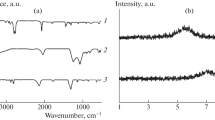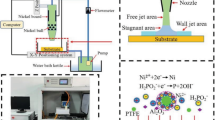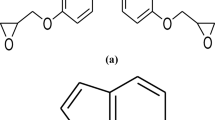Abstract
Low adhesion strength of polyurethane coating to a steel substrate is often attributed to poor steel preparation. However, the ratio of diisocyanate/polyol and dispersion of fillers within a polyurethane coating matrix influence the adhesion strength, optical and corrosion resistance properties. Poor dispersion of nano-fillers in a polymer coating matrix can lead to low adhesion strength, because close packing of nanoparticles often hides the hydroxyl groups required to form polar–polar bonds with the steel surface. This study combines sonication and high-shear mixing methods with shorter mixing times to prepare polyurethane nanocomposite coatings with various clay concentrations while keeping the ratio of diisocyanate/polyol constant. Fourier-transform infrared spectroscopy (FTIR), transmission electron microscopy (TEM) and X-ray diffraction, thermogravimetric analysis and pull-off are used to characterize polyurethane nanocomposite coatings. FTIR results confirm that sonication and high-shear mixing successfully prepare polyurethane-based coatings. TEM shows uniformly dispersed clay particles in polyurethane matrices. The adhesion strength improved on addition of 1–5 wt% C30B organoclay, with the highest improvement (34.4%) at 3 wt% loading. The corrosion resistance of polyurethane coatings was improved by the incorporation of organoclays into their matrices. Onset degradation temperature is also delayed by 4.1–8.5% as the clay concentration increased from 1 to 5 wt%.













Similar content being viewed by others
References
Guan SW (2003) 100% solids polyurethane and polyurea coatings technology coatings. Coat World 49–58
Bayer O, Muller E, Petersen S, Piepenbrink HF, Windemuth E (1950) Polyurethanes. VI. New highly elastic synthesis. Vulcollans Angew Chem 62:57
Varma AJ, Deshpande MD, Nadkarni VM (1985) Polyurethane/montmorillonite nanocomposites. Angew Makromol Chem 132:2003–2009
Kaushik A, Dheeraj A, Vipin S (2011) Synthesis and characterization of organically modified clay/castor oil based chain extended polyurethane nanocomposites. J Compos 42:1534–1541
Choudalakis G, Gotsis A (2009) Permeability of polymer/clay nanocomposites: a review. Eur Polym J 45:967–984
Ahmed NM, Abdel-Fatah HTM (2012) In recent researches in corrosion evaluation and protection. In: Razavi RS (ed) In Tech, Chap 4, p 67
Rehab A, Salahuddin N (2005) Nanocomposite materials based on polyurethane intercalated into montmorillonite clay. Mater Sci Eng A 399:368–376
Patel HM, Kachhia PH, Patel KS, Shah MD (2019) Synthesis of diphosphorus-based polyurethane esters and their application in flame-retardant nanoclay coatings. Poylm Bull. https://doi.org/10.1007/s00289-018-2440-9
Chang JH, An YU (2002) Nanocomposites of polyurethane with various organoclays: Thermomechanical properties, morphology, and gas permeability. J Polym Sci Part B Polym Phys 40:670–677
Solarski S, Benali S, Rochery M, Devaux E, Alexandre M, Monteverde F, Dubois P (2005) Synthesis of a polyurethane/clay nanocomposite used as coating: interactions between the counterions of clay and the isocyanate and incidence on the nanocomposite structure. J Appl Polym Sci 95:238–244
Nematollahi M, Heidarian M, Peikari M, Kassiriha S, Arianpouya N, Esmaeilpour M (2010) Comparison between the effect of nanoglass flake and montmorillonite organoclay on corrosion performance of epoxy coating. Corros Sci 52:1809–1817
Heidarian M, Shishesaz M, Kassiriha S, Nematollahi M (2010) Characterization of structure and corrosion resistivity of polyurethane/organoclay nanocomposite coatings prepared through an ultrasonication assisted process. Prog Org Coat 68:180–188
Varughese K, Review. DuPont Coatings. Web 2010 C, Alaa MA, Yusoh K, Hasany SF (2015) Synthesis and characterization of polyurethane–organoclay nanocomposites based on renewable castor oil polyols. Polym Bull 72:1–17
Ashhari S, Sarabi AA, Kasiriha SM, Zaarei D (2011) Aliphatic polyurethane–montmorillonite nanocomposite coatings: preparation, characterization, and anticorrosive properties. J Appl Polym Sci 119:523–529
Song M, Hourston D, Yao K, Tay J, Ansarifar M (2003) High performance nanocomposites of polyurethane elastomer and organically modified layered silicate. J Appl Polym Sci 90:3239–3243
Ahmad MB, Gharayebi Y, Salit MS, Hussein MZ, Shameli K (2011) Comparison of in situ polymerization and solution-dispersion techniques in the preparation of polyimide/montmorillonite (MMT) nanocomposites. Int J Molecul Sci 12:6040–6050
Chattopadhyay DK, Webster DC (2009) Thermal stability and flame retardancy of polyurethanes. Prog Polym Sci 34:1068–1133
Verma G, Kaushik A, Ghosh AK (2013) Comparative assessment of nano-morphology and properties of spray coated clear polyurethane coatings reinforced with different organoclays. Prog Org Coat 76:1046–1056
Joshi M, Banerjee K, Prasanth R, Thakare V (2006) Polymer/clay nanocomposite based coatings for enhanced gas barrier property. Indian J Fibre Text Res 31:202–214
Acknowledgements
Thanks to the Tshwane University of Technology for granting this study, Rand Water Company, South Africa, for funding this project and National Centre for Nanostructured Materials (NCNSM) for allowing the use of characterization facilities. Furthermore, I like to acknowledge Dr Vincent Ojijo, Mr Cliff Thompson and Dr Vincent Khumalo for their scientific guidance; Mr Mpho Motloung assisting and Dr Orebotse Botlhoko for assisting with the SAXS and contact angle measurements, respectively.
Author information
Authors and Affiliations
Corresponding author
Additional information
Publisher's Note
Springer Nature remains neutral with regard to jurisdictional claims in published maps and institutional affiliations.
Rights and permissions
About this article
Cite this article
Skosana, S.J., Khoathane, C. & Malwela, T. Enhancing the adhesion strength of polyurethane coatings by dispersing layered silicates via sonication and high-shear mixing method. Polym. Bull. 78, 203–221 (2021). https://doi.org/10.1007/s00289-020-03100-y
Received:
Revised:
Accepted:
Published:
Issue Date:
DOI: https://doi.org/10.1007/s00289-020-03100-y




